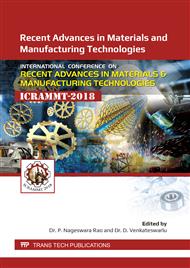[1]
R.Z. Valiev, Y.Estrin, Z.Horita, T.G. Langdon, M.J. Zechetbauer, Y.T. Zhu, Producing bulk ultrafine-grained materials by severe plastic deformation. Jom, 58(2006), 33-39.
DOI: 10.1007/s11837-006-0213-7
Google Scholar
[2]
H.Hu, A.Yu, N.Li, J.E. Allison, Potential magnesium alloys for high temperature die cast automotive applications: a review. Mater. Manuf. Processes , (2003), 687-717.
DOI: 10.1081/amp-120024970
Google Scholar
[3]
S. Nagarjuna, M. Srinivas, K. Balasubramanian, D.S. Sarmat, Effect of alloying content on high cycle fatigue behaviour of Cu-Ti alloys, Int. J. Fatigue 19 (1997), 51.
DOI: 10.1016/s0142-1123(96)00041-2
Google Scholar
[4]
S. Nagarjuna, M. Srinivas, K. Balasubramanian, D.S. Sarma, On the variation of mechanical properties with solute content in Cu–Ti alloys, Mater. Sci. Eng., A 259 (1999), 34.
DOI: 10.1016/s0921-5093(98)00882-x
Google Scholar
[5]
A. Szkliniarz, L. Blacha, W. Szkliniarz, J. Łabaj, Characteristics of Plasticity of Hot Deformed Cu-Ti Alloys, Arch of Metall. Mater, 1307 (2014).
DOI: 10.2478/amm-2014-0223
Google Scholar
[6]
A.El, M. I. A, El Mahallawy, N.Shehata, F. A.El Hameed, M. A.Yoon, E. Y., H.S. Kim. Wear properties of ECAP-processed ultrafine grained Al–Cu alloys. Mater. Sci. Eng., A, 527 (2010), 3726-3732.
DOI: 10.1016/j.msea.2010.03.057
Google Scholar
[7]
J.Li, J.Wongsa-Ngam, J.Xu, D.Shan, B.Guo, T.G. LangdonWear resistance of an ultrafine-grained Cu-Zr alloy processed by equal-channel angular pressing. Wear, 326(2015), 10-19.
DOI: 10.1016/j.wear.2014.12.022
Google Scholar
[8]
R.Gupta, S.Srivastava, S.K Panthi, N.K. Kumar.Multidirectional Forging of High-Leaded Tin Bronze: Effect on Wear Performance. Metall. Micr. Analysis, 6(2017), 577-590.
DOI: 10.1007/s13632-017-0394-1
Google Scholar
[9]
A.K. Padap, G.P. Chaudhari, S.K. Nath. Mechanical and dry sliding wear behavior of ultrafine-grained AISI 1024 steel processed using multiaxial forging. J. Mater. Sci, 45(17), 4837-4845.
DOI: 10.1007/s10853-010-4430-7
Google Scholar
[10]
G.K. Manjunath, K.U. Bhat, G.P. Kumar, M.R. Ramesh, Microstructure and Wear Performance of ECAP Processed Cast Al–Zn–Mg Alloys. Trans. Indian Inst. Met, (2018), 1-13.
DOI: 10.1007/s12666-018-1328-6
Google Scholar
[11]
T.G. Nieh, J. Wadsworth, Hall-petch relation in nanocrystalline solids, Scr. Metall. Mater, 25, (1991), 955.
DOI: 10.1016/0956-716x(91)90256-z
Google Scholar
[12]
J. Archard, Contact and Rubbing of Flat Surfaces, J. Appl. Phys., 24(1953), 981–988.
Google Scholar


